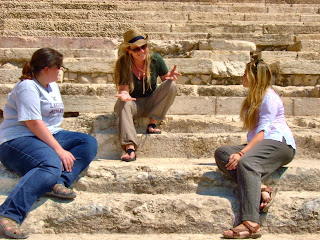Book Review of Jesus as the Fulfillment of the Temple in the Gospel of John

Paul M. Hoskins, Jesus as the Fulfillment of the Temple in the Gospel of John, Paternoster Biblical Monographs. Waynesboro, GA: Paternoster, 2006. xiv + 265pp. $35.00. Paper.
(Many thanks to James Stock from Wipf and Stock for sending me a review copy!)
Paul M. Hoskins, currently Assistant Professor of New Testament at Southwestern Baptist Theological Seminary, Fort Worth, Texas, has produced an immanently readable revison of his doctoral dissertation originally written at Trinity Evangelical under the supervision of D.A. Carson.
Hoskins aims in this volume are twofold. First, he seeks to "examine John's portayal of Jesus as the fulfillment and replacement of the Temple," and secondly, "to explore the possibility that the relationship between Jesus and the Temple may properly be described as typological." (2)
Maybe Hoskins biggest contribution in this work is located in his second objective, namely his methodological use of typology (18-36). Hoskins notes that two conceptions of typology exist in biblical scholarship, firstly, "the New Testament antitype fulfills and surpasses the patterns and predictions associated with the Old Testament type and in doing so takes the place of the type."(23) For those who hold to a historical-critical methodology, this view presents a 'hermeneutical dilemma' Hoskins notes, due to the fact that Old Testament authors were not aware of what they were predicting (23). Hoskins, helpfully describes a more canonical view of authorship, which posits God as Scripture's ultimate author (24-27).
The second conception of typology Hoskins describes places "particular emphasis upon the biblical authors' belief in 'the constant principles of God's working.'" (27) In this view, God works according to certain patterns in both the Old and New Testament, while minimizing the prospective view of Old Testament types. Hoskins opts for a more nuanced use of typology, citing Richard Davidson's Typology in Scripture: A Study of Hermeneutical ΤΥΠΟΣ Structures, which focuses "upon the use of typology found in the New Testament" allowing for interaction with proponents of both primary conceptions of typology "based upon how their conceptions match up with New Testament authors." (32)
In Chapter 2 Hoskins considers the history and significance of the temple in both the Old Testament and Second Temple literature (38-107). After reviewing the evidence, Hoskins concludes that the Temple as a divinely established institution for Israel was in a constant state of development with an expectation for a new, eternal Temple in Israel's hope for the future (107).
Chapter 3 (108-146) analyzes the four most frequently cited texts for Jesus as the replacement of the Temple in John's Gospel (1:14; 1:51; 2:18-22; 4:20-24). Hoskins concludes that in John 1:14 and 1:51 that Jesus is presented as the replacement and fulfillment of both the tabernacle and the Temple (1:14) and as the replacement of Bethel, the Tabernacle and Temple where God reveals himself to his people (1:51; 145). Hoskins astutely points out that Jesus is not "merely analogous to the holy places that preceded him; rather he fulfills these holy places as the greater Temple to which they pointed." (146) John 4:20-24 indicates that Jesus is now the loci for worship and John 2:18-22 hints at Jesus' replacement of the Temple not merely being relegated to the above mentioned texts, as Jesus' death, resurrection, and exaltation point to something further.
Chapter 4 (147-181), builds on the observations of the previous chapter, demonstrating the relationship established in the Gospel of John between the Temple and the Jewish feasts and the provision Jesus brings in his death, resurrection, and exaltation. For Hoskins, the language of lifting up and glorification marks Jesus' death/resurrection/exaltation "as the decisive event whereby God reveals himself for judgment and salvation." (181) Jesus' 'lifting up' and glorification demonstrates that as the 'true Temple' he inaugurates the age of salvation whereby God's people and the nations are gathered and provided for. Jesus is also the exemplar par excellence of the Jewish Feasts that took place in the Temple, whereby "he fulfills and replaces it as the place in and from which God pours out his abundant provision upon his people." (181)
Chapter 5 (182-193) discusses how Jesus fulfills and replaces the Temple. Here, Hoskins is at his best, describing the relationship as typological, returning at points to chapter one where the methodological framework for this study was put in place. This relationship is delineated in three major ways. First, the Old Testament type is institutional. Secondly, significant correspondence exists between the type and the antitype. Thirdly, movement from the type to the antitype is progressive in nature, with the antitype surpassing the type. (185) Hoskins rightly demonstrates that John's Gospel presents Jesus' relationship with the Temple as predictive in nature (e.g. John 1:45; 5:46; esp. John 19:36; 186-188). Hoskins also correctly notes that measures of continuity and discontinuity exist in John's presentation of Jesus vis-à-vis the Temple and other institutions (189). Terms such as 'fulfillment' and 'replacement' create too much ambiguity to be useful, that is why 'typological' explains the relationship more accurately (190-191).
Chapter 6 recapitulates the previous five chapters (194-197); Temple typology in the rest of the New Testament is discussed (197-201), and finally, further suggestions for typological study in the Fourth Gospel are discussed (i.e. Jacob, Israel, David, Sabbath, etc.; 202-203).
Hoskins writes clearly and his discussion of typology alone would make this an invaluable study. Further, his careful exegesis of key texts are marked with a scholarly maturity that surpasses most revised dissertations. Johannine and New Testament students in general should find plenty here with which to enjoy, critique and reflect.

Comments
Good review.